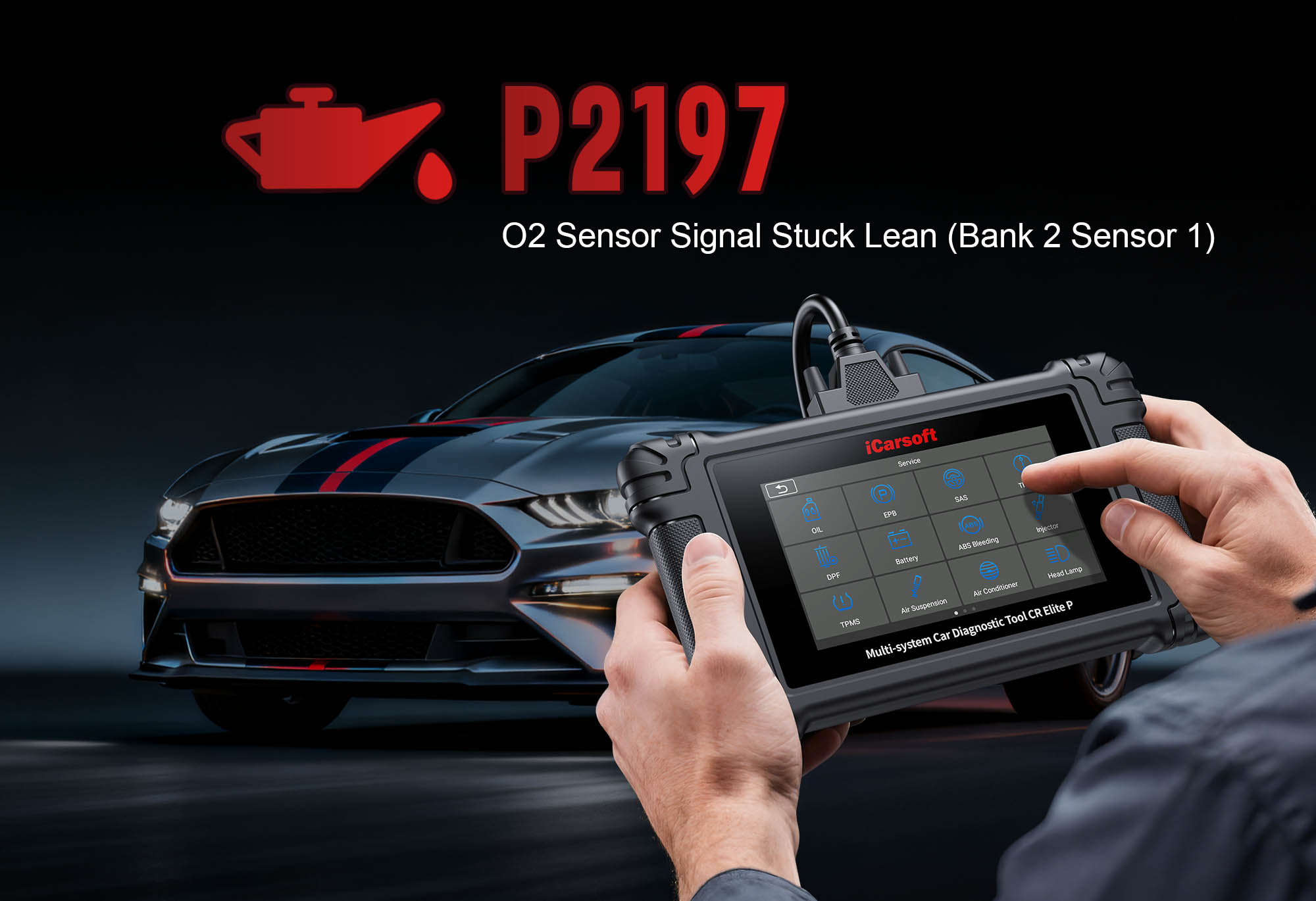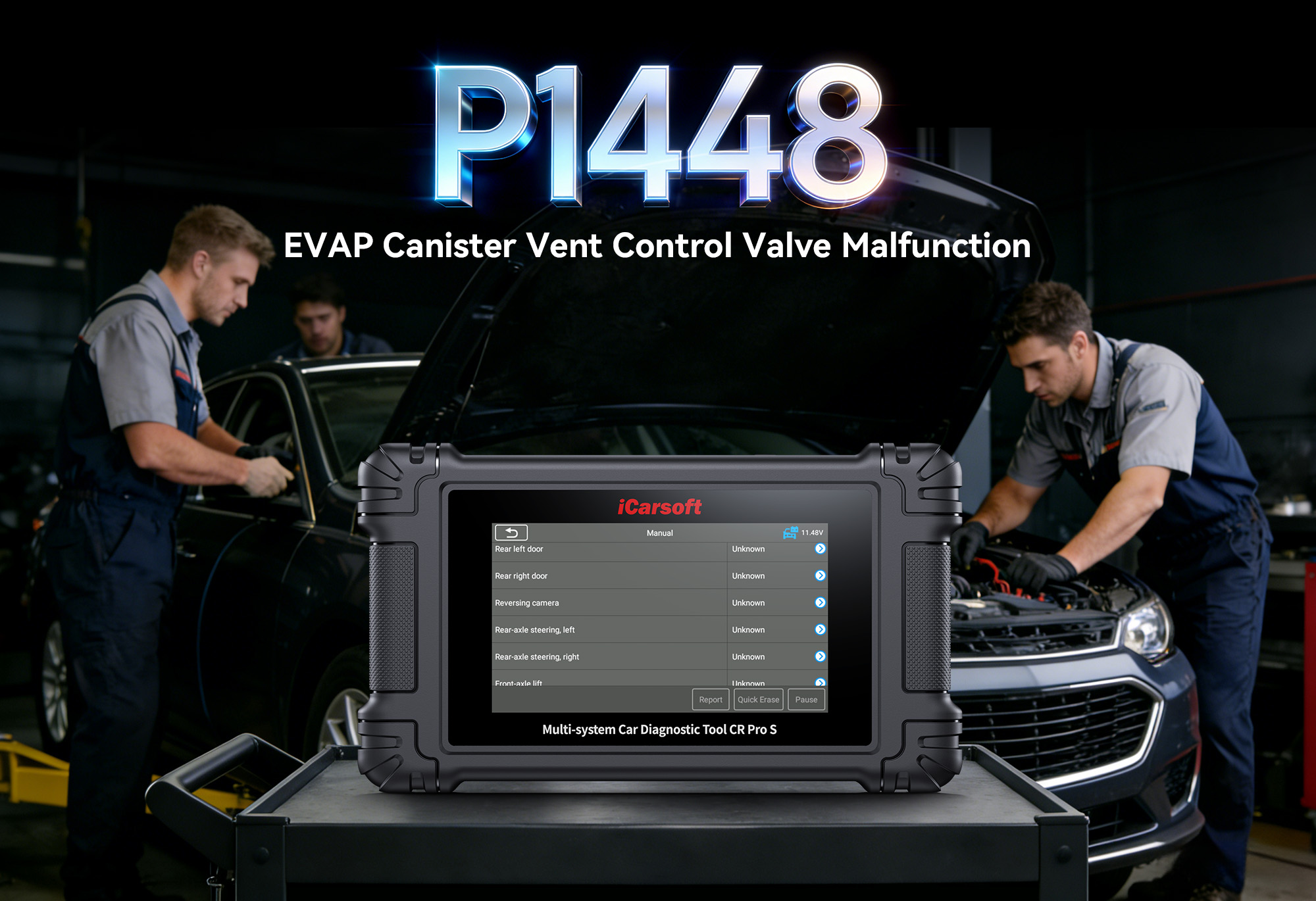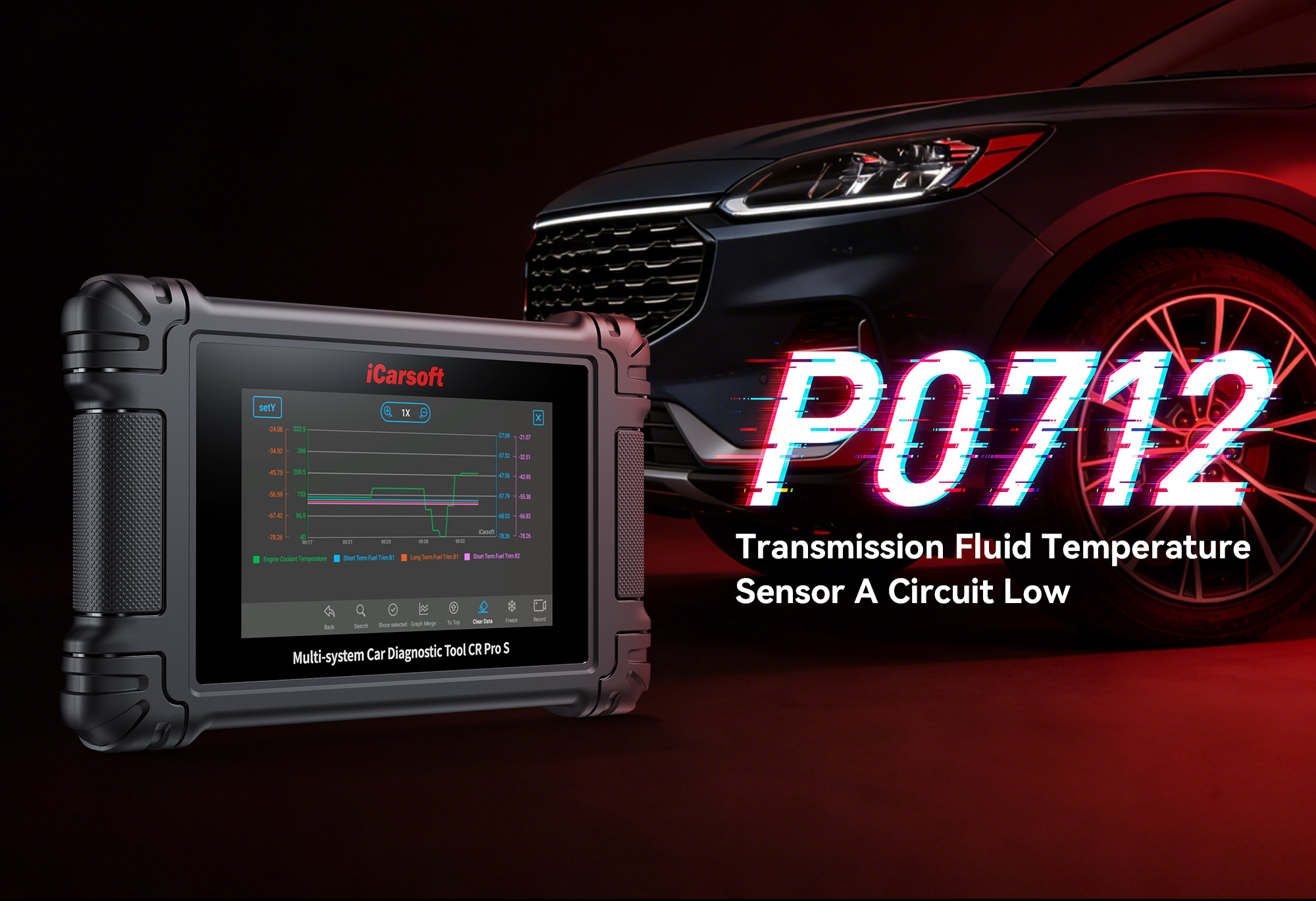Diagnose & Clear P2197 with iCarsoft CR Elite P: Fix O2 Sensor Stuck Rich (Bank 1, Sensor 1)
If your vehicle’s check engine light stays on, you notice a strong gasoline odor from the exhaust, or fuel efficiency drops sharply, a diagnostic scan will likely return P2197. This OBD-II code stands for "Oxygen (O2) Sensor Signal Stuck Rich – Bank 1, Sensor 1"—a critical fault indicating the pre-catalyst O2 sensor (mounted in the exhaust manifold of cylinder bank 1) is continuously detecting an excessively rich air-fuel mixture. The Engine Control Module (ECM) relies on this sensor to adjust fuel delivery; a stuck-rich signal tricks the ECM into reducing fuel, leading to poor performance, increased emissions, and potential damage to the catalytic converter.
Basic scanners may only flag "O2 sensor stuck rich" but can’t analyze sensor response speed, monitor fuel trim data, or test related components—leaving you guessing between a faulty sensor, leaky injector, or airflow issue. The iCarsoft CR Elite P, with its specialized O2 sensor diagnostics, live fuel trim tracking, and component tests, solves this. Let’s break down how to diagnose and resolve P2197 with precision, leveraging the CR Elite P’s unique capabilities to restore balanced combustion and engine efficiency.
Understanding P2197: Causes & Key Symptoms
A stuck-rich O2 sensor (Bank 1, Sensor 1) disrupts the ECM’s ability to optimize the air-fuel ratio (ideal ratio = 14.7:1 for gasoline engines). Symptoms worsen as unburned fuel accumulates in the exhaust, risking catalyst overheating and failed emissions tests:
Key Symptoms of P2197
-
Check Engine Light (CEL): The CEL illuminates steadily (not flashing) to alert you to the persistent rich signal—some vehicles also trigger a "Fuel System Fault" warning.
-
Strong Gasoline Odor: Unburned fuel in the exhaust creates a noticeable petrol smell, especially during idle or acceleration.
-
Reduced Fuel Efficiency: The ECM overcompensates for the rich signal by cutting fuel, but the underlying issue still causes wasted fuel—mileage can drop by 15–25%.
-
Rough Idle & Misfires: A rich mixture disrupts combustion, leading to shaky idling and occasional misfires (felt as "sputtering" when starting or stopping).
-
Catalytic Converter Overheating: Unburned fuel ignites in the catalyst, pushing temperatures above 1,600°F (870°C)—this can melt the catalyst’s internal structure, requiring costly replacement.
-
Failed Emissions Tests: High hydrocarbon (HC) and carbon monoxide (CO) levels from unburned fuel guarantee a failed state inspection.
Common Causes of P2197
|
Cause
|
Description
|
|
Faulty Bank 1, Sensor 1 O2 Sensor
|
Internal damage (e.g., worn heating element, contaminated sensing element) causes the sensor to send a constant rich signal, even if the mixture is balanced.
|
|
Leaky Fuel Injectors
|
Worn or cracked injectors drip fuel into the combustion chamber of cylinder bank 1, creating a locally rich mixture that the O2 sensor detects.
|
|
Clogged Air Filter
|
A dirty air filter restricts airflow to the engine, reducing the amount of air available for combustion—this creates a rich ratio (less air = more fuel relative to air).
|
|
Faulty Mass Airflow (MAF) Sensor
|
A dirty or failed MAF sensor underreports airflow to the ECM, leading the module to overfuel the engine (more fuel than needed for the actual air volume).
|
|
Vacuum Leaks (After MAF Sensor)
|
Leaks in the intake manifold (downstream of the MAF sensor) let unmeasured air enter the engine—confusing the ECM, which adds extra fuel to "balance" the mixture.
|
|
Fuel Pressure Regulator Failure
|
A stuck-open regulator increases fuel rail pressure, forcing more fuel into cylinder bank 1 than the ECM commands.
|
Why iCarsoft CR Elite P Excels at Diagnosing P2197
The CR Elite P outperforms basic tools with features tailored to O2 sensor and fuel system diagnostics—critical for resolving P2197:
Live O2 Sensor Signal Tracking
Monitors the Bank 1, Sensor 1 O2 sensor’s voltage in real time (normal range: 0.1V–0.9V). A constant voltage >0.6V confirms a stuck-rich signal.
O2 Sensor Response Test
Measures how quickly the sensor switches between lean (0.1V–0.4V) and rich (0.6V–0.9V) states—slow or no response indicates a faulty sensor.
Fuel Trim Analysis
Tracks short-term fuel trim (STFT) and long-term fuel trim (LTFT) for Bank 1. LTFT < -10% confirms the ECM is cutting fuel to compensate for a rich mixture.
MAF Sensor Validation
Tests the MAF sensor’s airflow readings against manufacturer specs—underreported airflow points to a MAF issue causing overfueling.
AutoVIN Identify
Automatically retrieves your vehicle’s make, model, and engine configuration in seconds, ensuring access to O2 sensor-specific specs.
Global Vehicle Coverage
Works with 500+ gasoline and hybrid models from Toyota, Ford, Chevrolet, Honda, BMW—supports narrowband and wideband O2 sensors.
Fuel Injector Balance Tests
Checks if injectors in Bank 1 are delivering equal fuel amounts—imbalanced flow indicates a leaky injector causing a rich mixture.
Step-by-Step: Diagnose P2197 with iCarsoft CR Elite P
-
1. Initial Basic Checks (Low-Cost Fixes First)
Start with simple inspections to rule out easy-to-resolve issues:
1. Inspect the Air Filter: Locate the air filter housing (near MAF sensor), remove the filter—replace if dirty/clogged with dust/debris.
2. Check for Fuel Leaks: Visually inspect Bank 1 fuel injectors, lines, and pressure regulator for dampness/stains—fix leaks immediately (fire hazard).
3. Examine Vacuum Hoses: Look for cracked/disconnected hoses in the intake manifold (after MAF sensor)—replace damaged hoses.
-
2. Connect the CR Elite P & Confirm P2197
1. Plug the CR Elite P into the OBD-II port. Power on and select AutoVIN Identify to detect engine type, Bank 1 position, and O2 sensor type.
2. Navigate to Engine > Fault Codes > Read Codes to confirm P2197. Tap Code Details for vehicle-specific insights (e.g., "Camry: O2 Stuck Rich; LTFT: -15%").
3. Resolve related codes (e.g., P0172, P0135) first—they indicate Bank 1 rich conditions or O2 sensor heating element failure.
-
3. Monitor Live O2 Sensor & Fuel Trim Data
Real-time data reveals if the issue is a faulty sensor or actual rich mixture:
1. Start the engine, idle 10–15 minutes (warm to operating temp >80°C).
2. Navigate to Engine > Live Data > O2 Sensors & Fuel Trim and monitor:
- Bank 1, Sensor 1 Voltage: Normal = switches 0.1V–0.9V every 1–2s; P2197 = stuck >0.6V (no switching).
- Bank 1 LTFT: Normal = -10% to +10%; < -10% = ECM cuts fuel (confirms actual rich mixture).
- MAF Airflow: Compare to specs (e.g., 2–5 g/s at idle)—low airflow = MAF/air filter issue.
-
4. Test the Bank 1, Sensor 1 O2 Sensor
Validate sensor functionality with specialized tests:
1. O2 Sensor Response Test: Navigate to Special Functions > Engine > O2 Sensor Response Test. Rev to 2,000 RPM—good sensors switch 5–10x in 10s; bad sensors switch <3x/stay stuck.
2. Heating Element Test: Select O2 Sensor Heating Test—checks if the element draws 12V and heats. No power = blown fuse; no heat = faulty sensor.
3. Location Note: Use Component Location > Engine > Exhaust > O2 Sensors to find Bank 1, Sensor 1 (usually on the front cylinder bank’s exhaust manifold).
-
5. Check Fuel Injectors (Bank 1)
Leaky injectors cause localized rich mixtures—test their balance:
1. Navigate to Special Functions > Engine > Injector Balance Test—tool compares fuel delivery across Bank 1 injectors.
2. Imbalanced flow (e.g., 20% difference) = leaky injector.
3. Visual Inspection: Remove intake manifold cover (if accessible) and check for wetness around Bank 1 injector tips/O-rings—replace leaky injectors with OEM parts (via Part Lookup).
-
6. Test the MAF Sensor & Fuel Pressure
Check for overfueling causes if injectors are good:
1. MAF Sensor Test: - Record airflow at idle/2,000 RPM via Live Data > MAF Sensor.
- Disconnect MAF sensor, restart engine—if P2197 clears temporarily, replace the sensor.
- Clean dirty MAF sensors with dedicated MAF cleaner (never brake cleaner), dry, and reinstall.
2. Fuel Pressure Test: - Connect a pressure gauge to the fuel rail test port (use CR Elite P adapter if needed).
- Compare gauge reading to specs (40–60 psi port injection, 2,000–3,000 psi direct injection)—high pressure = faulty fuel pressure regulator (replace).
-
7. Repair & Clear P2197
Fix the root cause:
- Faulty O2 Sensor: Replace Bank 1, Sensor 1 (match OEM parts via Part Lookup—e.g., Denso 234-4628). Torque to 18–22 Nm.
- Leaky Injectors: Replace faulty injectors, install new O-rings (use fuel injector lubricant).
- Clogged Air Filter/MAF: Replace filter or clean/replace MAF sensor.
- Faulty Fuel Regulator: Replace with system-compatible regulator (port vs. direct injection).
Clear the Code: Navigate to Engine > Fault Codes > Clear Codes and confirm P2197 is deleted.
-
8. Validate the Repair
Ensure O2 sensor functionality and balanced mixture:
1. Start the engine—no CEL or fuel system warnings.
2. Test drive 30–40 minutes (city + highway):
- No gasoline odor from exhaust.
- Smooth idle (no shaking/misfires).
- Improved fuel efficiency (check Fuel Economy Tracker on supported models).
3. Post-Repair Data: Confirm Bank 1, Sensor 1 voltage switches 0.1V–0.9V and LTFT is -10% to +10%.
4. Run I/M Readiness Test (under OBDII Functions) for emissions compliance.
Preventing P2197 Recurrence
The CR Elite P helps maintain O2 sensor and fuel system health:
-
O2 Sensor Maintenance: Use Service Reminder to replace pre-catalyst O2 sensors (Bank 1, Sensor 1) every 100,000 miles—they degrade over time.
-
Air Filter Replacement: Schedule changes every 15,000–30,000 miles (more often in dusty areas) to prevent airflow restrictions.
-
Fuel System Cleaning: Add fuel injector cleaner every 10,000 miles (follow Fuel System Guide recommendations) to prevent injector deposits.
-
MAF Sensor Cleaning: Clean the MAF sensor every 30,000 miles with dedicated MAF cleaner to maintain accurate airflow readings.
Conclusion
P2197’s stuck-rich O2 sensor fault threatens fuel efficiency, emissions compliance, and catalytic converter health—but the iCarsoft CR Elite P turns complex diagnostics into a straightforward process. With its O2 sensor tests, fuel trim tracking, and injector balance checks, you can quickly identify whether to replace a $50 sensor or address a $200 injector issue—no guesswork required.
For DIYers and professionals alike, the CR Elite P’s O2 sensor expertise, global coverage, and intuitive interface make it the ideal tool for resolving P2197. Restore balanced combustion, save on fuel costs, and keep your vehicle emissions-compliant—all with one professional-grade diagnostic tool.
FAQs About P2197 Code
Q: How do I identify which side is Bank 1?
A: Bank 1 is the cylinder bank containing the #1 cylinder. Use the CR Elite P’s Component Location > Engine > Cylinder Banks to find #1 cylinder position—for most vehicles, it’s the bank closest to the front of the engine.
Q: Can I drive with P2197?
A: Short trips (to a repair shop) are acceptable, but prolonged driving risks catalytic converter damage from overheating. Fix P2197 within 100 miles to avoid costly catalyst replacement.
Q: Why does P2197 return after O2 sensor replacement?
A: Unresolved underlying issues—e.g., leaky injectors, dirty MAF sensor, or fuel pressure problems. Use the CR Elite P’s live fuel trim data to retest and confirm the rich mixture is fixed.
Q: Do I need a special tool to replace the O2 sensor?
A: A standard O2 sensor socket (available at auto parts stores) works for most sensors. The CR Elite P’s Torque Guide provides the correct torque spec (usually 18–22 Nm) to avoid damaging the exhaust manifold threads.





